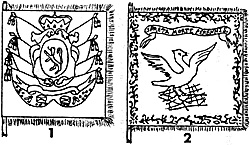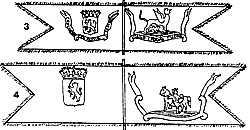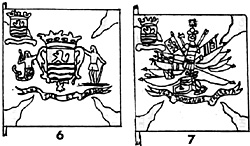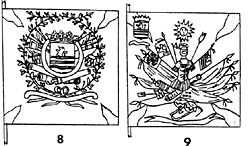DESCRIPTIONS
All Dutch national infantry battalions with the exception of the Swiss carried two colors. The "Principal" (Colonel's) color was white, while the 'Second" color could be blue, green, red, or even white without relation to the unit's facing color. The Swiss carried one color per company of which one was a white "Colonel's" color. Dutch cavalry carried one standard per squadron, while dragoons carried one guidon per regiment!
The finials, and cords and tassels of all colors and standards are gold, and it is assumed that the reverse of the color is the same as the obverse unless indicated otherwise.
Nos. 1 thru 5 illustrate the patterns of the 4 Dutch cavalry standards and the 3 dragoon guidons represented in the Triomphes.
 1. Two standards of this pattern, probably
belonging to a regiment from the province of Holland, and captured at the
Battle of Laeffelt, July 1747. One standard has a white Field and the other
a red field. In the center a golden lion on a red field surrounded by a
golden frame. The frame surmounted by a princely crown of red with white
ermine trim and gold frame, orb and cross. Trophies of flags are blue,
white, yellow and red from top to bottom. The red trophy on the red standard
has an orange tinge to set it off from the red background, Finials, cords
and tassels of the trophies are gold. Ribbon is blue without inscription.
Drums, cannon barrels and cannonballs are silver/white. Fringe is gold,
as are the Finials, and cords and tassels of the standards. The pattern
of these standards resembles that of the colors belonging to Infantry Regiments
Waldeck (Nos. 33 and 35, but that prince raised no cavalry regiments. The
appearance of the reverse is not known. It could be a duplicate of the
obverse, or like Waldeck, contain the coat-of-arms of the colonel within
the frame.
1. Two standards of this pattern, probably
belonging to a regiment from the province of Holland, and captured at the
Battle of Laeffelt, July 1747. One standard has a white Field and the other
a red field. In the center a golden lion on a red field surrounded by a
golden frame. The frame surmounted by a princely crown of red with white
ermine trim and gold frame, orb and cross. Trophies of flags are blue,
white, yellow and red from top to bottom. The red trophy on the red standard
has an orange tinge to set it off from the red background, Finials, cords
and tassels of the trophies are gold. Ribbon is blue without inscription.
Drums, cannon barrels and cannonballs are silver/white. Fringe is gold,
as are the Finials, and cords and tassels of the standards. The pattern
of these standards resembles that of the colors belonging to Infantry Regiments
Waldeck (Nos. 33 and 35, but that prince raised no cavalry regiments. The
appearance of the reverse is not known. It could be a duplicate of the
obverse, or like Waldeck, contain the coat-of-arms of the colonel within
the frame.
2. Two standards of this pattern and exactly the same were taken with the capture of Brussels in February 1746. The only cavalry regiment in the city when it surrendered was the Carabinier regiment. White field. Silver bird, probably a phoenix, on a golden nest or pyre. Silver ribbon with gold inscription SPRETA MORTE PERENNIS. Decorative scroll work around the edges in gold. Fringe, finials, cords and tassels in gold. Reverse probably the same as the obverse.
 3. A dragoon guidons taken at Brussels in
February 1746. The only dragoon regiment in the city was vanMassou's. White
Field. Obverse: a golden dragon (?) with two smaller golden dragons suckling
all on a green base. Ribbon is silver with inscription VIGILO STERNO TUEOR
in gold. Reverse: a red shield with a golden lion. In the lion's left paw
a sheaf of brown arrows with silver heads and feathers and in the right
paw, a sword with silver blade and gold hilt and grip. Above the shield
a golden crown lined red. A silver ribbon with the inscription CONCORDIA
RES PARVAE CRESCUNT in gold. Silver fringe and Finials. Gold cord and tassels.
3. A dragoon guidons taken at Brussels in
February 1746. The only dragoon regiment in the city was vanMassou's. White
Field. Obverse: a golden dragon (?) with two smaller golden dragons suckling
all on a green base. Ribbon is silver with inscription VIGILO STERNO TUEOR
in gold. Reverse: a red shield with a golden lion. In the lion's left paw
a sheaf of brown arrows with silver heads and feathers and in the right
paw, a sword with silver blade and gold hilt and grip. Above the shield
a golden crown lined red. A silver ribbon with the inscription CONCORDIA
RES PARVAE CRESCUNT in gold. Silver fringe and Finials. Gold cord and tassels.
4. Probably de Martha's Dragoon Regiment. Taken with the capture of Mons in July 1746. White field. Obverse: a gray horse with red saddle. Rider in a medium blue coat with red cuffs and breeches; white belts, black scabbards, gold sword hilt and grip; black boots and hat, the latter trimmed in gold; white gloves. Horse and rider standing on a earth brown base. Gold ribbon without inscription. Reverse: a red shield with a gold lion holding a sheaf of brown arrows with silver heads and feathers in it's left paw, and a silver blade sword with gold hilt and grip in its right. Gold crown lined red with blue, red and white stones in its base. Silver fringe and Finials, gold cords and tassels.
 5. Probably either the Gardes Dragoon Regiment
or Schlippenbach's Dragoon Regiment, and taken at the Battle of Laeffelt
in July 1747. White Field. Obverse: a gold dragoon (?) standing on golden
drums which have pinkish drum heads and are draped with a blue cloth trimmed
gold; golden cannon barrels' trophies on the right are blue, silver and
gold from top to bottom, and on the left are white, gold and silver, all
finials are gold; the ribbon is white without inscription. Reverse: a golden
shield with a red lion which has blue claws and tongue; a gold crown lined
red and with red stones in its base; light golden branches; gold ribbon
without inscription. Fringe, Finials, cords and tassels are gold.
5. Probably either the Gardes Dragoon Regiment
or Schlippenbach's Dragoon Regiment, and taken at the Battle of Laeffelt
in July 1747. White Field. Obverse: a gold dragoon (?) standing on golden
drums which have pinkish drum heads and are draped with a blue cloth trimmed
gold; golden cannon barrels' trophies on the right are blue, silver and
gold from top to bottom, and on the left are white, gold and silver, all
finials are gold; the ribbon is white without inscription. Reverse: a golden
shield with a red lion which has blue claws and tongue; a gold crown lined
red and with red stones in its base; light golden branches; gold ribbon
without inscription. Fringe, Finials, cords and tassels are gold.
Nos. 6 thru 9 illustrate the colors of Zeeland infantry regiments.
 6. Probably the Principal Color of Infantry
Regiment Brazil. This color is described as taken at Fontenoy, however,
there were no Zeeland regiments present at that battle. On the other hand,
IR Brauw became prisoners of war when Audenarde was surrendered to the
French in July 1745. White field with green corner flames. In the center
the coat-of-arms of the province of Zeeland; a shield divided in two, the
upper half-gold with a red lion, the lower half alternating from the top
medium blue and white wavy bars; a golden frame and crown lined red. Supporter
on the right Caucasian flesh with light blue shorts and a light brown club,
he is standing on a greenish brown base; blue ribbon with gold inscription
LUI TUR ET EMERGO. In the upper inner corner the coat-of-arms of Zeeland
without the frame. Underneath a blue ribbon with an inscription in gold.
6. Probably the Principal Color of Infantry
Regiment Brazil. This color is described as taken at Fontenoy, however,
there were no Zeeland regiments present at that battle. On the other hand,
IR Brauw became prisoners of war when Audenarde was surrendered to the
French in July 1745. White field with green corner flames. In the center
the coat-of-arms of the province of Zeeland; a shield divided in two, the
upper half-gold with a red lion, the lower half alternating from the top
medium blue and white wavy bars; a golden frame and crown lined red. Supporter
on the right Caucasian flesh with light blue shorts and a light brown club,
he is standing on a greenish brown base; blue ribbon with gold inscription
LUI TUR ET EMERGO. In the upper inner corner the coat-of-arms of Zeeland
without the frame. Underneath a blue ribbon with an inscription in gold.
7. Probably the Second Color of IR Brauw. Green field with white corner flames. In the upper, inner corner the coat-of-arms of the province of Zeeland (see 6). and a blue ribbon wih an inscription in gold. In the center a golden sun in splendor over a 'trophy of arms": a suit of armor in silver with a gold chain around the waist and trim to the collar, silver helmet with red interior visible at visor opening, three white feather plumes; on the right from the top a brown pole with gold end device, a flag with the coat-of-arms of Zeeland, Five flags in order red, gold, blue, white and white; on the left from the top a halberd with brown shaft and silver blade, a gold flag with red lion, a red flag with a sheaf of brown arrows with silver heads and feathers, a blue flag, a white flag, silver barrel device with two gold bands, a gold flag, a silver drum with gold ropes, a light brown rammer staff, a red flag; under the suit of armor a pile of golden yellow cannonballs, two silver drums with gold cloth trim, silver shield trimmed gold and with a center spike of gold, and a silver device under the right hand drum; a blue ribbon with an inscription NISI DOMINUS TRUSITA in gold.
 8. Probably the Principal Color of IR Swanenberg
captured when Mons surrendered to the French in July 1746. A white field
with white corner flames. In the center the coat-of-arms of Zeeland (see
No. 6) surmounted by a gold crown lined red with blue and red stones in
its base. A blue ribbon surrounds the coat-of-arms. On either side of the
coat-of-arms are trophies of arms. On the right from the top are a gold
trumpet, a blue flag, a white standard, a reddish brown rammer staff, a
red flag and a red drum with white drumhead and ropes. On the left a reddish
brown rammer staff, a red flag, a white standard, a blue flag, a red drum
with white drumhead and ropes and to its left the end of a gold horn. The
two cannon barrels on top are tied together with a red ribbon. The wreath
is green and tied together with a red ribbon. The other ribbon is blue
with inscription.
8. Probably the Principal Color of IR Swanenberg
captured when Mons surrendered to the French in July 1746. A white field
with white corner flames. In the center the coat-of-arms of Zeeland (see
No. 6) surmounted by a gold crown lined red with blue and red stones in
its base. A blue ribbon surrounds the coat-of-arms. On either side of the
coat-of-arms are trophies of arms. On the right from the top are a gold
trumpet, a blue flag, a white standard, a reddish brown rammer staff, a
red flag and a red drum with white drumhead and ropes. On the left a reddish
brown rammer staff, a red flag, a white standard, a blue flag, a red drum
with white drumhead and ropes and to its left the end of a gold horn. The
two cannon barrels on top are tied together with a red ribbon. The wreath
is green and tied together with a red ribbon. The other ribbon is blue
with inscription.
9. Probably the Second Color of IR Swanenberg and captured at Mons in July 1746. Similar in design to that of IR Brauw above. A white field with light red corner flames. In the upper, inner corner the coat-of arms of Zeeland (see No. 6), a gold crown lined red and a blue ribbon without inscription. In the center a golden sun in splendor. Underneath, a trophy of arms consisting of a silver suit of armor, a silver helmet with red interior visible at die visor and three white feather plumes; on the right from the top a gold device, a flag with the coat-of-arms of Zeeland, a red flag, a yellow flag, a blue flag, and two white flags; on the left from the top a silver halberd, a gold flag with a red lion, a red flag with a sheaf of brown arrows with silver heads and feathers, a blue flag, a white flag, a silver device with gold bands and a silver arrow, a yellow flag, a silver spade/shovel, a silver drum with white drumhead and gold ropes and rim, a red flag; the two cannon barrels are yellow; the cannonballs are silver, the two lower drums are silver with white drumheads and blue trimmed gold cloth skirts; a silver shield trimmed gold and a gold spike; the ribbon is blue without inscription. The finials and cords of all the flags in the trophy are gold.
-
Dutch Colors in WAS Introduction
Gederland colors, Utrecht standards
Friesland colors
Overijssel colors
Back to Table of Contents -- Courier #63
Back to Courier List of Issues
Back to Master Magazine List
© Copyright 1993 by The Courier Publishing Company.
This article appears in MagWeb (Magazine Web) on the Internet World Wide Web.
Other military history articles and gaming articles are available at http://www.magweb.com